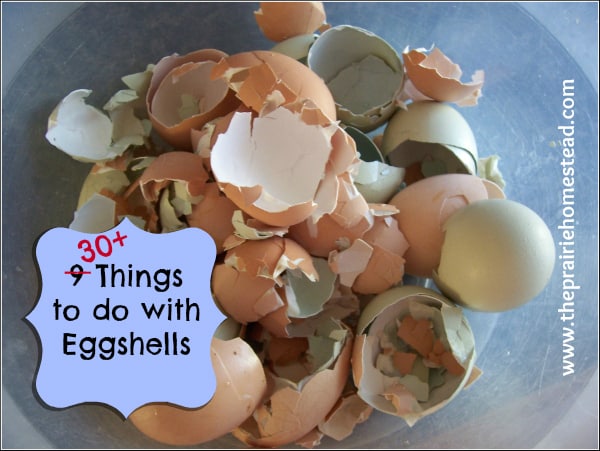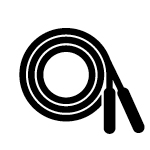30+ Things to Do with Eggshells
 To the majority of people, eggshells are simply trash.
To the majority of people, eggshells are simply trash.But to homesteader or natural living enthusiast, eggshells are a surprisingly useful resource.
I personally get a big kick out of finding uses for things people normally throw away. So, I’ve put together a list of
9 Things You Can Do with Eggshells around your own homestead.
(Holy Moly! My list started out with a measly 9 ideas, but after all of my thrify readers left their ideas in the comment section, it has grown to 30+! I’ve edited the list with these new additions- keep them coming folks!)**It is very important to only use eggshells from healthy, natural chickens if you or your animals are going to ingest the shells. Eggs from factory farms are not only less nutritious, but can also carry harmful pathogens. I personally have no problem eating raw eggs from my own free-range hens, but I wouldn’t do so with eggs from the store.**
1. Feed them to your chickens.
Boost your flock’s calcium intake by crushing the shells and feeding them back to your hens. My girls much prefer crushed egg shells over the oyster shell supplement from the feed store.
I wrote a post a while back that has all the details of collecting, crushing, and feeding the shells.
2. Use the shell’s membrane as an all-natural bandage.
I just discovered this idea, so I have yet to try it, but what a cool concept! The membrane of the shell is reported to help promote healing in cuts and scratches.
This post should be able to answer most of your questions about using membranes as a first-aid tool.
3. Boil the shells in your coffee.
My first thought when I read this idea was ”
Why on earth would you do that?” But apparently, people have been boiling eggshells in their coffe for centuries to help clarify the grounds and reduce bitterness. I have yet to give this a try myself, but it might be worth a try. Here is a
Boiled Eggshell Coffee tutorial.
4. Sprinkle the shells around your garden to deter pests.
Soft-bodied critters like slugs or snails don’t like crawling over sharp pieces of shell.
5. Give your tomatoes a calcium boost.
Blossom-end rot is a common tomato problem, but I recently learned that it is actually caused by a
calcium deficiency in the plant. Experienced gardeners often place eggshells in the bottom of the hole when transplanting their tomato plants to help combat this problem. I’m definitely trying this next year!
6. Eat them.
Yeah, I know. First I told you to
eat your weeds, and now I’m saying to eat eggshells…
Hey, I never claimed to be normal.

But yes, many folks actually do eat eggshells for their awesome amounts of calcium. I’ve never actually tried it, but I know that several of my readers have. This post will give you all the info you need to
make your own calcium-rich eggshell powder.
7. Use them to start seedlings.
If
homemade paper pots aren’t your style, give some of your smaller seedlings a start in rinsed-out shells.
This post from Apartment Therapy will give you all the info and photos you need to get you started.
8. Toss them in the compost pile.
Add calcium to your compost by adding shells to your pile or tumbler.
9. Sow directly into the soil.
If none of the previous idea sound appealing and you don’t have a compost pile, then you can simply turn crushed shells directly into your garden patch. It’s still better than sending them to the garbage.
All of the following ideas were submitted by readers of The Prairie Homestead:
10.
Potting Soil Addition: Used coffee grounds and egg shells are wonderful in potted plants. I use a 1:4 ratio.
(From Tala)11.
Blade Sharpening: Keep them in the freezer and use to clean and sharpen blender blades by adding water. Then pour the mixture into your compost bin.
(From Greenie and Ceridwyn)12.
Canine Remedy: I save mine and let them dry out, when I have a good size amount I crush them, then use a coffee grinder and make them into a powder. If one of my dogs get diarrhea, I just sprinkle a couple teaspoons of the powder on their food for a day and the diarrhea goes away.
(From Terri)13.
Calcium Pills: I save my eggshells in a large bowl, then I steam them to sanitize them and let them dry. Then I grind them down (I use a vitamix but I think any blender would do if you crush them a little first, or just do it in a coffee grinder) into a fine powder and spoon them into 00 gelatin capsules for homemade calcium pills.
(From Mari)14.
Mineral supplement: I sometimes soak egg shells in lemon water for a few weeks in the fridge. Then I add a tiny bit to my shakes to get extra minerals.
(From Jill)15.
Tooth Remineralizing:
Natural News.com has an article about using comfrey root & fresh egg shell (organic & pasture raised) for re-mineralizing your teeth. Not sure about this particular method, but it would make sense due to the healing properties of the comfrey AND the minerals in the egg shell.
(From Jennifer)16.
Sidewalk chalk: 5-8 egg shells (finely ground), 1 tsp hot water, 1 tsp flour, food coloring optional…mix and pack into toilet tissue rolls and let dry.
(From Linda) 17.
First Aid Treatment: Fresh egg membranes applied, then allowed to dry, will “draw” minor infections: splinter, pimple, boil, etc.
(From Anne)
18.
Making Water Kefir: You can also use egg shell to nourish your water kefir grains. You just add 1/4 of a clean egg shell to your water kefir while it’s brewing. We’ve done this instead of buying mineral drops and it seems to work great.
(From Jenna, Sherry, and Tiffani)19.
Christmas Ornaments: When I found a large cache of slightly-flawed plastic suncatcher ornaments to paint cheap at the local flea market a few years ago, I snatched a big bunch of them up. I mixed regular acrylic colors with Elmer’s glue and various “texturizing” elements to pack those suncatchers with. I tried everything from small seeds and spices, to sifted sand, and my favorite turned out to be crushed egg shells. They were no longer transparent, but the flaws were covered, and they make very nice Christmas tree ornaments, wall hangings, mobiles, etc.
(From Sweetp)20.
Make Calcium Citrate: Make your own calcium citrate using only fresh farm raised, preferably organic, egg shells. Rinse residual egg out of the shells and air dry. Crush the shell and add 1t. lemon juice per egg shell and cover. The lemon juice will dissolve the shell and there you have it… calcium citrate.
(From Mary Anne)21.
Calcium-Rich Vinegar: I was taught by my herbalist teacher to make a calcium rich vinegar by adding calcium rich herbs (nettles, dock, etc) and one clean high quality eggshell to apple cider vinegar. It needs to infuse for at least six weeks, then be decanted. But the calcium from the shell and the plants goes into the vinegar and can be used as regular vinegar would be in salad dressing, over cooked greens, etc.
(From Sara)22.
Pan Scrubber: Crushed egg shells work great to scrub pans that have food stuck in them. Yes they will break up, but they still do the job!
(From Rose)23.
Ice Cream Addition (?): I was told companies put egg shell powder in cheap ice cream to add extra calcium. I imagine you could do this when making homemade ice cream as well.
(From Brenda)24.
Comestic Booster: Make it into a powder and add a little bit to your nail polish to strengthen nails. Take that same powder and put it into ice cube trays with water and rub it on your face– it helps reduce the look of wrinkles. Put the powder in your lotion– it softens your hands.
(From Amy)25.
Add to Broth/Stocks: For extra calcium and minerals.
(From Becky and Tiffani)26.
Arts and Crafts: Use to make mosaics or mixed-media art projects.
(From Carol and Janet)27.
House Plant Booster: My Grandmother kept eggshells covered with water in a mason jar which she used to water her African violets. She had the most magnificent plants imaginable!
(From Cynthia)28.
Wild Bird Treat: You can also feed them to the birds. They’re high in calcium and are great for birds in the spring when they are laying eggs– just make sure to sterilize them. Bake them in the oven for 20 minutes at 250 F and crush them.
(From Susanne)29.
Laundry Whitener: To help your whites not to turn greyish, put a handful of clean and broken down eggshells and 2 slices of lemon in a little cheesecloth bag with your clothes in the washer. It will prevent the soap deposit that turns the white clothes grey.
(From Emilie)30.
Garbage Disposal Cleaner: Toss a few shells down your disposal to help freshen things up.
(From Carol)What do you do with eggshells? Share in the comments and I’ll add your ideas to this post!This post was shared at: Monday Mania, Frugally Sustainable, Simple Lives Thursday, Fresh Bites Friday, Farm Gal Frida




















